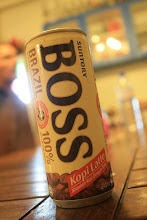
Introducing Guest #1...
...and guest #2.

Parking garages are the new parking garages.
Our first full day was spent wandering through Osaka. We managed to avoid the confusing train system all day, instead opting to hoof around. By the end of the day, we walked through the two main tourist areas in Osaka, tried Takoyaki (a.k.a. squid balls) and the deluxe Japanese Ramien.
I hadn't done much reading up on Japan, or the cities we were planning to visit, so many things took me by surprise throughout this trip. Osaka, for example, has an apparently large bicycle infrastructure that people seem to use. The city is very flat, I would also consider it sprawled (11,893 people per square KM), but I have been living in Seoul (17,288 people per square KM) for a year so who knows. At any rate, while walking around town, we noticed many people riding utilitarian bikes, from kids to business associates. One of the most memorable moments was seeing a business woman, in a nice dress, come out of an office building, strap her purse/briefcase to her bike, drop the kickstand and move on.
Although the streets are wide, and many of them include some kind of protected shoulder for bicycle passage, many of the sidewalks are also equipped with a marked bicycle lane, and almost all the crosswalks have bike striping. People tend to ride on the sidewalks and lock their bikes near the curb. It's all very fascinating coming from Portland, where the bicycle infrastructure is in rampant development. Seeing all this in action, I had a quandary: Why can't this work in Portland? It seems to me, cyclists in Osaka have no problem sharing the sidewalk with pedestrians and visa versa. Not only are they nonchalant about sharing, but when the stupid foreigners can't figure out which side to pass, they don't seem to mind the dance.
--Warning: Osaka is no longer mentioned.--
Cross the Pacific to Portland, and you have a completely opposite vibe. T(here), the ideal multi-modal transportation system is developed in segregation. Cars are separated from bikes, which are separated from pedestrians. Everyone has a strong sense of entitlement to their current mode.
If any user neglects to use their designated area, thus impeding upon another's designated area, everyone is in uproar; the smooth synchronicity has been violated. Think bikes on the sidewalk/in the car lane, pedestrians/cars in bike lanes, etc. I think a clear separation is necessary to cool the chaos and provide safety. I also understand the sidewalks in Portland are not built for bikes and pedestrians. But should that change? Why should a bicycle be subjected to a car lane (assuming a bike lane is not present) when they want to move along slowly. Doesn't it seem safer for everyone to keep the slow riders on the sidewalk in this event? Should we replace a car lane to make wider sidewalks in Portland, or should we instead implement a cycle track?
Ultimately I'm going to conclude that the bike way should be the priority, to continue the separation. It could all come down to a cultural difference between Portland and Osaka. Or it could be the little person/big ego vibe Portland procures with it's bicycle culture, I simply needed to write it all out to come to a conclusion.
Thanks for listening.


















































